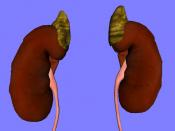General Information:
Adrenoleukodystrophy (ALD) is a term used to refer to a genetic disorder that disrupts the adrenal glands due to the removal of white matter from the nerve fibers in an individual's brain which causes neuro-degeneration or deterioration. The main cause of ALD would be a mutation in the gene that codes for a protein that is involved in a metabolic process.
The onset of this genetic disorder may occur during two stages of a male affected by adrenoleukodystrophy. During childhood between ages four and eight, the ALD sufferer will develop symptoms that usually include attention deficit disorder, seizures, and impairment of the senses, and then those symptoms are followed by complete motor disability within two years. The disorder may be referred to as adrenomyeloneuropathy if the symptoms, such as progressive paraparesis, sphincter disturbances, and varying degrees of distal sensory loss, are manifested during adulthood so the AMN affected individual only suffers from mild symptoms compared to children who have ALD.
There are a few gross anatomy issues that ALD causes, including peroxisomal ATP-binding cassette (ABC) protein malfunction, central nervous system deterioration, and non-functioning adrenal glands. Normally, the human cell takes saturated very long chain fatty acids (VLCFA) into an organelle known as the peroxisome with an ABC transporter protein. In the peroxisome, the VLCFAs are broken down into an acetyl-CoA molecule fragment and another carbon chain attached to coenzyme a (CoA). However, a person with ALD is unable to break down the VLCFAs into two smaller fragments due to the fact that an adrenoleukodystrophy protein (ALDP) exists instead of another functional ABC protein. As VLCFAs build up throughout the body, the central nervous system begins to deteriorate since these fatty acids will damage the white electrical insulation wrapping (myelin sheath) that is wrapped around the axons. Consequently,


